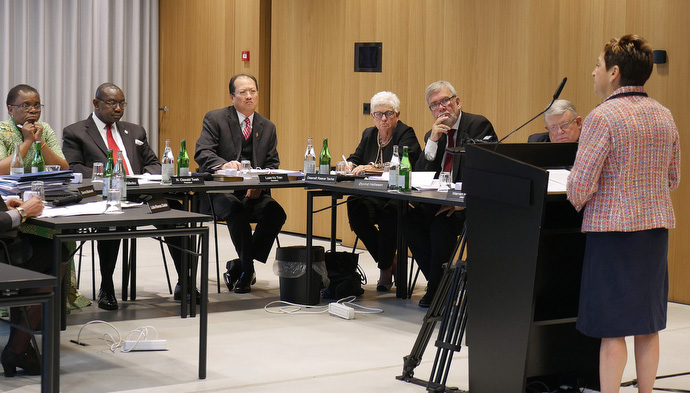 Bishop Cynthia Fierro Harvey addresses the United Methodist Judicial Council meeting in Zurich. The council ruled Oct. 26 that the One Church Plan is largely constitutional, but found problems with the Traditional Plan. Photo by Diane Degnan, UMCom.
Bishop Cynthia Fierro Harvey addresses the United Methodist Judicial Council meeting in Zurich. The council ruled Oct. 26 that the One Church Plan is largely constitutional, but found problems with the Traditional Plan. Photo by Diane Degnan, UMCom.
ZURICH, Switzerland (UMNS)–A review of possible plans for the future direction of The United Methodist Church found the One Church Plan to be largely constitutional, said a decision released Oct. 26 by the denomination’s top court.
In Decision 1366, which was unanimous, the United Methodist Judicial Council found more problems in the Traditional Plan petitions that would need to be addressed before that plan could pass a constitutional test.
Since another legislative proposal–the Connectional Conference Plan–contains proposed constitutional changes required for implementation, the court ruled it has no authority to scrutinize the plan at this time. Read the Judicial Council full Decision 1366.
Next February, a special session of General Conference, the denomination’s top legislative body, will meet in St. Louis to consider these three legislative proposals from a report by the Commission on a Way Forward, as well as any other petitions considered “in harmony” with the call for a special General Conference.
The commission is an advisory body that was appointed by the Council of Bishops following General Conference 2016 in hopes of finding a way to overcome fundamental disagreements within the church about homosexuality. Read the UM News Service full story. View archived video from the 5-hour Council session webcast at UMC.org/live.
Initial responses to Judicial Council ruling
“The Judicial Council statement recognizes that our denomination is ‘multi-leveled and global in scope,’ but we are local in our ‘contextualization and differentiation,'” Bishop Peggy Johnson pointed out in responding to the ruling by the church high court on the constitutionality of two Commission on a Way Forward plans. “It goes on to say that we ‘don’t require uniformity.’ I believe this is how we live together with the most grace and respect.
“I know our churches have various hearts around many social issues,” she continued. “Yet, we are one in Christ Jesus, nonetheless. May we remain one in Christ and listen to everyone’s perspective and experience. This is how we as a Christian community can best grow in faith.”
The Rev. Dawn Taylor-Storm, co-leader of the Eastern PA Conference delegation to General Conference, centered her response in prayer.
“I am thankful for the prayerful response of our Judicial Council,” she said. “Please continue to pray for our delegation as we enter these final months of preparation. Above all, may our mission to make disciples remain the center of our daily work.”
Both the Council of Bishops (COB) and the two bishops leading the UMC’s Commission on a Way Forward also issued statements responding to the Judicial Council’s rulings.<
Bishop Sandra Steiner Ball and Bishop David Yemba are the commission’s remaining moderators. Bishop Ken Carter, a former moderator, now serves as President of the Council.
“We thank the Judicial Council for their diligent work in analyzing the plans and giving guidance to the delegates, so they can do their best work,” reads the commission’s statement. “Using the General Conference legislative process, individual Commission members will work alongside delegates to think through how all three plans might be amended based on the analysis of the Judicial Council.
“Our prayer remains the same, that God, Father, Son and Holy Spirit, will use the work of the Commission to maximize the presence of a United Methodist witness in as many places of the world as possible. We invite the church to continue to pray for our church as we seek to make disciples of Jesus for the transformation of the world.”
“The Council of Bishops wishes to thank the Judicial Council for their work, understanding that it was complicated and complex yet sought to fulfill the mission of the church,” reads Bishop Carter’s statement on behalf of the COB. “We continue to be guided by two core convictions: We want to help the delegates to do their best work at the Called General Conference, and we are seeking a way forward for the church that ‘maximizes the presence of the United Methodist witness in as many places in the world as possible, that allows for as much contextual differentiation as possible, and with a desire for as much unity as possible.'”
